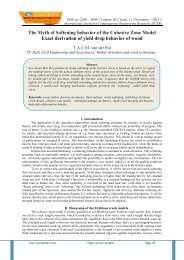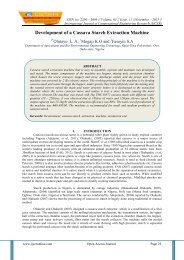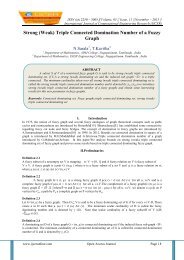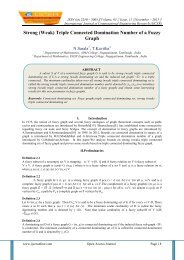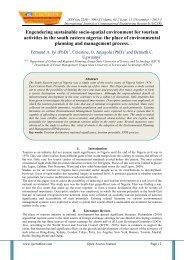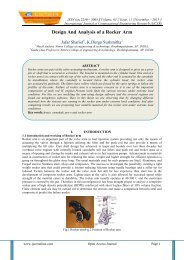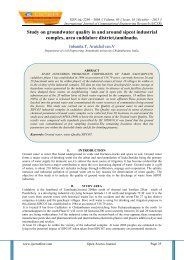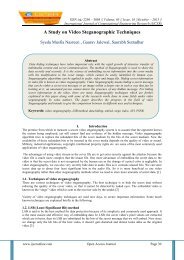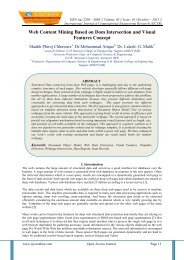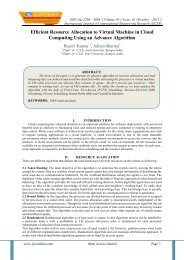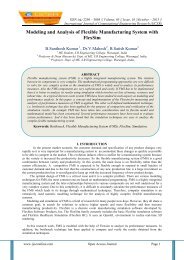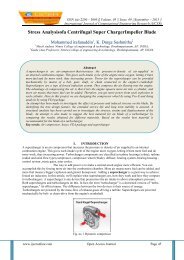Create successful ePaper yourself
Turn your PDF publications into a flip-book with our unique Google optimized e-Paper software.
ISSN (e): 2250 – 3005 || Volume, 05 || Issue, 10 ||October – 2015 ||<br />
International Journal of Computational Engineering Research (IJCER)<br />
Sub-Graph Finding Information over Nebula Networks<br />
K.Eswara Rao $1 , A.NagaBhushana Rao $2<br />
$1,$2<br />
Asst. Professor, Dept. Of CSE, AITAM, Tekkali, SKLM, AP, INDIA.<br />
ABSTRACT<br />
Social and information networks have been extensively studied over years. This paper studies a<br />
new query on sub graph search on heterogeneous networks. Given an uncertain network of N objects,<br />
where each object is associated with a network to an underlying critical problem of discovering, topk<br />
sub graphs of entities with rare and surprising associations returns k objects such that the expected<br />
matching sub graph queries efficiently involves, Compute all matching sub graphs which satisfy<br />
“Nebula computing requests” and this query is useful in ranking such results based on the rarity and<br />
the interestingness of the associations among nebula requests in the sub graphs. “In evaluating Top<br />
k-selection queries, “we compute information nebula using a global structural context similarity, and<br />
our similarity measure is independent of connection sub graphs”. We need to compute the previous<br />
work on the matching problem can be harnessed for expected best for a naive ranking after matching<br />
for large graphs. Top k-selection sets and search for the optimal selection set with the large graphs;<br />
sub graphs may have enormous number of matches. In this paper, we identify several important<br />
properties of top-k selection queries, We propose novel top–K mechanisms to exploit these indexes<br />
for answering interesting sub graph queries efficiently.<br />
Key words: Nebula Networks, Top-k sub graph, Indexing<br />
I. INTRODUCTION<br />
With the ever-increasing popularity of entity-centric applications, it becomes very important to study the<br />
interactions between entities, which are captured using edges in the entity relationship (or information) nebula<br />
networks. Entity-relationship networks with multiple types of entities are usually referred to as heterogeneous<br />
information networks. For example, bibliographic networks capture associations like „Identification of<br />
fingerprints for the serine protease Family‟. Similarly, social networks, biological protein-enzyme classification<br />
Using SVM ((support vector machine), Wikipedia entity network, etc. also capture a variety of rich associations.<br />
In these applications, it is critical to detect novel connections or associations among objects based on some<br />
subgraph queries. Two example problems are shown in Figures1 and are described as follows.<br />
Fig.1 Attack Localization Problem<br />
P1: query Selection over nebula: Organization Nebula networks consist of two subgraphs and object nodes<br />
where two graphs are connected if they have worked together on a successful mission in the past, and a<br />
subgraph is linked to an nebula if the person has a known expertise in using that subgraph. For example, US<br />
army network which consists of 2-3M nebulas and much more linked objects. A manager in such an<br />
organization may have a mission which can be defined by a query graph of objects and networks. For example,<br />
the right half of Figure 1 shows an organization network while the left half of the figure shows a sample mission<br />
www.ijceronline.com Open Access Journal Page 21
Sub-Graph Finding Information over…<br />
query graph consisting of two subgraphs. The network has edges with weights such that a high weight implies<br />
higher compatibility between the nodes connected by the edge. The manager is interested in selecting a<br />
subgraph to accomplish the mission with the network to network compatibilities as specified in the mission<br />
query. Using the historical compatibility based organization network, how can we find the best query (selection)<br />
over the nebula?<br />
P2: Attack Localization: Consider a computer network as shown in the left part of Figure 2. It can consist of a<br />
large number of components like database servers, hubs, switches, desktops, routers, VOIP phones, etc.<br />
Consider a simple attack on multiple web servers in such a network where the attack script runs on a<br />
compromised web server. The script reads a lot of data from the database server (through the network hub) and<br />
sends out spam emails through the email server. Such an attack leads to an increase in data transfer rate along<br />
the connections in multiple “attack sub-networks” of the form as shown in the right part of the figure. Many<br />
such attacks follow the same pattern of increase in data transfer rates. How can a network administrator localize<br />
such attacks quickly and find the worst affected sub-networks given the observed data transfer rates across all<br />
the links in the network?<br />
Fig.2 Example of a Network G and a Query Q<br />
Both of these problems share a common underlying problem: Given a heterogeneous network G, a<br />
heterogeneous subgraph query Q, and an edge interestingness measure I which defines the edge weight, find the<br />
top-K matching subgraphs S with the highest interestingness. The two problems can be expressed in terms of the<br />
underlying problem as follows. P1: G = organization network, Q = mission query, I = historical compatibility, S<br />
= team. P2: G = computer network, Q = an “attack sub-network” query, I = data transfer rate, S = critical subnetworks.<br />
Besides the two tasks, this proposed problem finds numerous other applications. For example, the<br />
interesting subgraph matches can be useful in network bottleneck discovery based on link bandwidth on<br />
computer networks, suspicious relationship discovery in social networks, de-noising the data by identifying<br />
noisy associations in data integration systems, etc.<br />
Comparison with Previous Work<br />
The proposed problem falls into the category of the subgraph matching problems. Subgraph matching has been<br />
studied in the graph query processing literature with respect to approximate matches [4], [25], [26], [30] and<br />
exact matches [18], [27], [31]. Subgraph match queries have also been proposed for RDF graphs [15],<br />
probabilistic graphs [24] and temporal graphs [1]. The proposed problem can be solved by first finding all<br />
matches for the query using the existing graph matching methods and then ranking the matches. The cost of<br />
exhaustive enumeration for all the matches can be prohibitive for large graphs. Hence, this paper proposes a<br />
more efficient solution to the top-K subgraph matching problem which exploits novel graph indexes. Many<br />
different forms of top-K queries on graphs have been studied in the literature [5], [21], [23], [28], [30]. Gou et<br />
al. [5] solve the problem only for twig queries while we solve the problem for general subgraphs. Yan et al. [21]<br />
deal with the problem of finding top-K highest aggregate values over their h-hop neighbors, in which no<br />
subgraph queries are involved. Zhu et al. [28] aim at finding top-K largest frequent patterns from a graph, which<br />
does not involve a subgraph query either. Different from existing top-K work, the proposed work deals with a<br />
novel definition of top-K general subgraph match queries, which have a large number of practical applications<br />
as discussed above.<br />
www.ijceronline.com Open Access Journal Page 22
Sub-Graph Finding Information over…<br />
Brief Overview of Top-K Interesting Subgraph Discovery<br />
Given a heterogeneous network containing entities of various types, and a subgraph query, the aim is to find the<br />
top-K matching subgraphs from the network. We study the following two aspects of this problem in a tightly<br />
integrated.<br />
way: (1) computing all possible matching subgraphs from the network, and (2) computing interestingness score<br />
for each match by aggregating the weights of each of its edges. To solve these problems, we present an efficient<br />
solution which exploits two low-cost index structures (a graph topology index and a maximum metapath weight<br />
(MMW) index) to perform top-K ranking while matching (RWM). Multiple applications of the top-K heuristic,<br />
a smart ordering of edges for query processing, quick pruning of the edge lists using the topology index and the<br />
computation of tight upper bound scores using the MMW index contribute to the efficiency of the proposed<br />
solution in answering the top-K interesting subgraph queries.<br />
Summary<br />
We make the following contributions in this paper. We propose the problem of top-K interesting subgraph<br />
discovery in information networks given a heterogeneous edge-weighted network and a heterogeneous<br />
unweighted query. To solve this problem, we propose two low-cost indexes (a graph topology index and a<br />
maximum metapath weight (MMW) index) which summarize the network topology and provide an upper bound<br />
on maximum metapath weights separately. Using these indexes, we provide a ranking while Matching (RWM)<br />
algorithm with multiple applications of the top-K heuristic to answer interesting subgraph queries on large<br />
graphs efficiently. Using extensive experiments on several synthetic datasets, we compare the efficiency of the<br />
proposed RWM methodology with the simple ranking after matching (RAM) baseline. We also show<br />
effectiveness of RWM on two real datasets with detailed analysis. Our paper is organized as follows. In Section<br />
II, we define the top-K interesting subgraph discovery problem. The proposed approach consists of two phases:<br />
an offline index construction phase and an online query processing phase which are detailed in Sections III and<br />
IV respectively. In Section V, we discuss various general scenarios in which the proposed approach can be<br />
applied. We present results with detailed insights on several synthetic and real datasets in Section VI. We<br />
discuss related work and summarize the paper in Sections VII and VIII respectively.<br />
II. PROBLEM DEFINITION<br />
In this section, we formalize the problem definition and present an overview of the proposed system. We start<br />
with an introduction to some preliminary concepts.<br />
Definition 1 (A Heterogeneous Network). A heterogeneous network is an undirected graph<br />
G = < V G , E G , type G , weight G > where V G is a finite set of vertices (representing entities) and E G is a finite set<br />
of edges each being an unordered pair of distinct vertices. type G is a function defined on the vertex set as type G :<br />
V G → T G where T G is the set of entity types and |T G | = T. weight G is a function defined on the edge set as<br />
weight G : E G → R [0, 1]. Weight G (e) represents the interestingness measure value associated with the edge e.<br />
For example, Figure 3 shows a network G with three types of nodes. T G = {A,B,C}. |V G |=13, and |E G |=18.<br />
Definition 2 (Subgraph Query on a Network). A subgraph query Q on a network G is a graph consisting of<br />
node set V Q and edge set E Q . Each node could be of any type from T G .<br />
For example, Figure 2 shows a query Q with four nodes. |V Q |=4, and |E Q |=3. The network G and the query Q<br />
shown in Figure 2 will be used as a running example throughout this paper.<br />
Definition 3 (Subgraph Isomorphism). A graph g = is subgraph isomorphic to another graph<br />
g′ = if there exists a subgraph isomorphism from g to g′. A subgraph isomorphism is an<br />
injective function M : V g →V g′ such that (1) ∀v ∈ Vg, M(v) ∈ V g′ and type g (v)=type g′ (M(v)), (2) ∀e =(u, v)<br />
∈ E g , e′ =(M(u), M(v))∈ E g′ .<br />
Definition 4 (Match). The query graph Q can be subgraph isomorphic to multiple subgraphs of G. Each such<br />
subgraph of G is called a match or a matching subgraph of G. The query Q can be answered by returning all<br />
exact matching subgraphs from G. For example, the subgraph of G induced by vertices (8, 9, 5, 6) is a match for<br />
the query Q on network G shown in Figure 2. For sake of brevity, we will use the vertex set (tuple notation) to<br />
refer to the subgraph induced by the vertex set.<br />
Definition 5 (Interestingness Score). The interestingness score for a match M for a query Q in a graph G is<br />
defined as the sum of its edge weights. For example, the interestingness score for the occurrence {8,9, 5, 6} is<br />
2.1. Though we use sum as an aggregation function here, any other monotonic aggregation function could also<br />
be used.<br />
www.ijceronline.com Open Access Journal Page 23
Sub-Graph Finding Information over…<br />
Definition 6 (Top–K Interesting Subgraph Discovery Problem).<br />
Given: A heterogeneous information network G, a heterogeneous unweighted query Q, and an edge<br />
interestingness measure.<br />
Find: Top-K matching subgraphs with highest interestingness scores.<br />
For example, (3, 4, 5, 6) and (4, 3, 2, 7) are the Top two matching sub-graphs both with the score 2.2 for the<br />
query Q on network G in Figure 2.<br />
For example, the metapath corresponding to the path (5, 4,7) is (A,A,B). There are TD distinct metapaths of<br />
length D where T is the number of types. Each column of a topology index corresponds to a metapath.<br />
Fig-3 Top-K interesting sub graph Discovery System Diagram<br />
Figure 2 shows the graph topology index for the first 4 nodes of the graph shown in Figure 2. For example, for<br />
node 2, there are two 2-hop neighbors of type A (4 and 8) reachable via the metapath (B,A). Hence the entry<br />
topology(2, (B,A))=2. A blank entry in the index indicates that there is no node of type t at a distance d from<br />
node n along the corresponding metapath. As we shall see in Section IV-A, the topology index plays a crucial<br />
role in reducing the search space by pruning away candidate graph nodes that cannot be instantiated for a given<br />
query node.<br />
III. TOP-K INTERESTING SUBGRAPH QUERY PROCESSING<br />
Given a query Q with node set VQ and edge set EQ, top-K matching subgraphs are discovered by traversing the<br />
sorted edge lists in the top to bottom order with the following speedup heuristics. First for each node in V Q , a set<br />
of nodes from the graph that could be potential candidates for the query node, is identified using the topology<br />
index (Algorithm 1). The edges in the sorted edge lists that contain nodes other than the potential candidate<br />
nodes are marked as invalid. This prunes away many edges and speeds up the edge list traversal. The query Q is<br />
then processed using these edge lists in a way similar to the top-K join query processing (Section IV-B) adapted<br />
significantly to handle network queries. The approach discussed in Section IV-B is further made faster by the<br />
tighter upper bound scores computed using the MMW index (Algorithm 2). We will discuss these in detail in<br />
this section.<br />
Algorithm 1 Candidate Node Filtering Algorithm<br />
---------------------------------------------------------------------------------------------------------------<br />
Input: (1) Query Node q, (2) Graph Node p, (3) topology<br />
[p], (4) queryTopology[q],<br />
(5) Index Parameter D<br />
Output: Is p a potential candidate node for query node q?<br />
1: for d = 1 . . .D do<br />
2: for mp = 1 . . . T d do<br />
3: if queryTopology[q][d][mp] > topology<br />
[p][d][mp]<br />
then<br />
4: Return False<br />
5: Return True<br />
---------------------------------------------------------------------------------------------------------------<br />
Candidate Node Filtering Algorithm<br />
The proposed candidate node filtering approach is summarized in Algorithm 1. For each distance value d, all<br />
possible metapaths of length d are checked. By comparing the topology for all metapaths with the corresponding<br />
query Topology values (Step 3), it can be inferred whether the candidate p is valid to be an instantiation of<br />
www.ijceronline.com Open Access Journal Page 24
Sub-Graph Finding Information over…<br />
query node q for some match. The time complexity is O(DTD+1). Candidate pruning leads to shortening of the<br />
edge lists associated with any of the query edges. For example, nodes 2, 8 and 10 get pruned for the query node<br />
Q2. Thus, the edge list corresponding to the query edge (Q2,Q3) will have the following AA edges marked as<br />
invalid: (2,3), (8,9) and (10,9).<br />
B. Top-K Match Computation<br />
In this sub-section, we describe the top-K algorithm to perform interestingness scoring and matching<br />
simultaneously. The algorithm is based on the following key idea. A top-K heap is maintained which stores the<br />
best K answers seen so far. The sorted edge lists are traversed from top to bottom. Each time an edge with<br />
maximum edge weight from any of the lists is picked and all possible size-1 matches in which that edge can<br />
occur are computed. Candidate size-1 matches are grown one edge at a time till they grow to the size of the<br />
query. Partially grown candidate matches can be discarded if the upper bound score of these matches falls below<br />
the minimum element in the top-K heap. The algorithm terminates when no subgraph using the remaining edges<br />
can result into a candidate match with upper bound score greater than the minimum element in the top-K heap.<br />
We discuss the details below.<br />
Definition 7 (Valid Edge). A valid edge e with respect to a query edge qE is a graph edge such that both of its<br />
endpoints are contained in the potential candidate set for the correspond ing query nodes in qE. Recall that the<br />
potential candidate set for each query node is computed using Algorithm 1.<br />
The sorted edge lists are quite similar to the lists in Fagin‟s TA [4]. To traverse the edge lists in the top to<br />
bottom order, a pointer is maintained with every edge list. The pointers are initialized to point to the topmost<br />
graph edge in the sorted edge list, which is valid for at least one query edge. As the pointers move down the<br />
lists, they move to the next valid edge rather than moving to the next edge in the list (as in Fagin‟s TA).<br />
Definition 8 (Size-c candidate match). A size-c candidate match is a partially grown match such that c of its<br />
edges have been instantiated using the matching graph edges.<br />
VI. EXPERIMENTS<br />
We perform experiments on multiple synthetic datasets each of which simulates power law graphs. We evaluate<br />
the results on the real datasets using case studies. We perform a comprehensive analysis of the objects in the top<br />
subgraphs returned by the proposed algorithm to justify their interestingness. Data and<br />
code is available at http://dais.cs.uiuc.edu/manish/RWM/.<br />
A. Synthetic Datasets<br />
We construct 4 synthetic graphs using the R-MAT graph generator in GT-Graph software [2]: G1, G2, G3 and<br />
G4 with 103, 104, 105, and 106 nodes respectively. Each graph has a number of edges equal to 10 times the<br />
number of nodes. Thus, we consider graphs with exponential increase in graph size. Each node is assigned a<br />
random type from 1 to 5. Also, each edge is assigned a weight chosen uniformly randomly between 0 and 1. All<br />
the experiments were performed on an Intel Xeon CPU X5650 4-Core 2.67GHz machine with 24GB memory<br />
running Linux 3.2.0. The code is written in Java. The distance parameter D for the indexes is set to 2 for both<br />
the proposed approach RWM (Ranking While Matching) and the baseline RAM (Ranking After Matching),<br />
unless specified explicitly. Also unless specified explicitly, we are interested in computing top 10 interesting<br />
subgraphs (K=10) and the execution times mentioned in the tables and the plots are obtained by repeating the<br />
experiments 10 times.<br />
Baseline: Ranking After Matching (RAM)<br />
The problem of finding the matches of a query Q in a heterogeneous network G has been studied earlier [20],<br />
[27]. In [27], the authors present an index structure called SPath. SPath stores for every node,a list of its typed<br />
neighbors at a distance d for 1≤d≤ D. SPath index is then used to efficiently find matches for a query in a pathat-a-time<br />
way: the query is first decomposed into a set of shortest paths and then the matches are generated one<br />
path at a time. This method is used as a baseline.<br />
Index Construction Time<br />
Figure 4 shows the index construction times for the various indexes. Generating the sorted edge lists is very fast.<br />
Even for the largest graph with a million nodes, the sorted edge lists creation takes around 40 seconds. The<br />
Topology+MMW (D=2) and SPath (D=2) curves show the time required for construction of these indexes, for<br />
various graph sizes. The X axis denotes the number of nodes in the synthetic graphs and the Y axis shows the<br />
index construction time in seconds. Note the Y axis is plotted using a log scale.<br />
The index construction time rises linearly as the graph size grows. Also, as expected the index construction time<br />
rises as D increases.<br />
www.ijceronline.com Open Access Journal Page 25
Sub-Graph Finding Information over…<br />
Index Size<br />
Figure 4 shows the size of each index for different values of D. The X axis plots the number of nodes in the<br />
synthetic graphs and the Y axis plots the size of the index (in KBs) using a logarithmic scale. Different curves<br />
plot the sizes of various indexes, and the graph. Note that the size of the topology index and the MMW index for<br />
D=2 is actually smaller than the size of the graph. Even when the index parameter is increased to D=3, the<br />
topology and the MMW indexes remain much smaller than the SPath index for D=2. For D=3, the SPath index<br />
grows very fast as the size of the graph increases. As expected as the graph size increases, the size of each index<br />
increases. While the increase is manageable for the Edge lists, the MMW index and the topology index, the<br />
increase in SPath index size is humongous.<br />
Query Execution Time<br />
We experiment with three types of queries: path, clique and general subgraphs, of sizes from 2 to 5. We present<br />
a comparison of different techniques for the graph G2 using the indexes with D=2.<br />
|V Q |= 2 |V Q |= 3 |V Q |= 4 |V Q |= 5<br />
RAM 245 2004 14628 169328<br />
RWM0 15 32 43 122<br />
RWM1 19 36 98 178<br />
RWM2 20 40 442 6887<br />
RWM3 218 1733 2337 3933<br />
RWM4 18 34 42 118<br />
Table I<br />
Query Execution time (MESC) for Path queries<br />
(Graph G2 and Indexes with D=2)<br />
|V Q |= 2 |V Q |= 3 |V Q |= 4 |V Q |= 5<br />
RAM 144 8698 34639 174992<br />
RWM0 11 376 14789 229236<br />
RWM1 14 448 16789 200075<br />
RWM2 13 567 19089 201709<br />
RWM3 157 2279 17184 161545<br />
RWM4 12 347 13567 198617<br />
The tables I- II show the average execution times for an average of 10 queries per experimental setting each<br />
repeated 10 times. The six different techniques are as follows: RAM (the ranking after matching baseline),<br />
RWM0 (without using the candidate node filtering), RWM1 (without using the MMW index), RWM2 (same as<br />
RWM1 without the pruning any partially grown candidates), RWM3 (same as RWM1 without the global Top-K<br />
quit check), RWM4 (same as RWM1 with the MMW index). Clearly, RAM takes muchlonger execution times<br />
for all types of queries. We observed that the larger the number of candidate matches, the more the execution<br />
time gap between the RAM method and the RWM methods. An interesting case is |V Q |=5 for the clique queries.<br />
Actually there are very few (less than 10) cliques of size 5 of a particular type in the graph. Hence, we can see<br />
that almost all the approaches take almost the same time. In this case, the Top-K computation overheads<br />
associated with the RWM approaches and lack of pruning result in relatively lower execution time for RAM.<br />
Next, note that RWM4 usually performs faster than RWM1. The time savings are higher for the path queries<br />
compared to the subgraph or clique queries. This is expected because the upper bound scores computed in<br />
RWM4 are tighter only if most of the query structure can be covered by the non overlapping paths. Also,<br />
RWM0 performs slightly better than RWM4 for smaller query sizes, but candidate node filtering helps<br />
significantly as query size increases.<br />
Table-III shows the time split between the candidate filtering step and the actual Top–K execution. Note that the<br />
candidate filtering takes a very small fraction of the total query execution time.<br />
|V Q |=2 |V Q |=3 |V Q |=4 |V Q |=5<br />
RAM 158 3186 39294 469962<br />
RWM0 10 165 824 4660<br />
RWM1 12 195 1022 5891<br />
RWM2 12 212 3135 27363<br />
RWM3 111 1486 3978 9972<br />
RWM4 12 165 791 4518<br />
www.ijceronline.com Open Access Journal Page 26
Table –III<br />
Query Execution Time (Msec) for Subgraph Queries (Graph G2 and Indexes With D=2)<br />
Query<br />
size<br />
|V Q | = 2 |V Q | = 3 |V Q | = 4 |V Q | = 5<br />
Query<br />
Type CFT TET CFT TET CFT TET CFT TET<br />
Sub-Graph Finding Information over…<br />
Table –IV<br />
Path 8 10 10 24 10 32 12 106<br />
Clique 5 6 8 ## 9 13538 9 2E+05<br />
Subgraph 6 6 9 ## 10 781 12 4506<br />
10000<br />
1000<br />
100<br />
10<br />
1<br />
|Q| |Q| |Q| |Q|<br />
Fig. 5 Query Execution Time for Different Values of K<br />
Scalability Results<br />
We run the 20 path and general subgraph queries (each 10 times) over all the 4 synthetic graphs using RWM4<br />
and present the results in Table IV. The table shows that the execution time increases linearly with the graph<br />
size, and exponentially with the query size. Even though the execution time is exponential in query size, (1) that<br />
is the case with most subgraph matching algorithms, and (2) intuitive user queries are limited in size by limits of<br />
human interpretability for most applications. Effect of Varying the K Figure-5 shows the effect of varying K on<br />
20 path and general subgraph queries on graph G2 using RWM4. As expected, the query execution time<br />
increases as K increases. However, the increase in execution time is reasonably small enough making the system<br />
usable even for larger values of K.<br />
|V Q |=<br />
2<br />
|VQ |=<br />
3<br />
|VQ |=<br />
4<br />
# SIZE-1<br />
Candidates 9.55 7.87 4.38 1.63<br />
# SIZE-2<br />
Candidates 29.28 19.31 8.94<br />
# SIZE-3<br />
Candidates 24.42 24.5<br />
# SIZE-4<br />
Candidates 14.61<br />
TABLE V<br />
Number of candidates as percentage of total matches for different query sizes and candidates sizes<br />
|VQ<br />
|= 5<br />
Table-V shows the percentage of candidates of different sizes with respect to the total number of matches. The<br />
results shown in this table are obtained by running the algorithm for the 20 path and subgraph queries on graph<br />
G2. We removed the clique queries because the number of cliques of size 5 matching such queries is less than<br />
10 and hence no pruning occurs. Note that on an average, the number of candidates is around 14% of the total<br />
number of matches. Clearly, for subgraph queries there are candidates of higher sizes also, but the number of<br />
such candidates is much smaller (< 1%) compared to the number of matches, and so we do not show them here.<br />
V. RELATED WORK<br />
The network (graph) query problem can be formulated as a selection operator on graph databases and has been<br />
studied first in the theory literature as the subgraph isomorphism problem [3], [14], [20]. One way of answering<br />
network queries is to store the underlying graph structure in relational tables and then use join operations.<br />
However, joins are expensive, and so fast algorithms have been proposed for approximate<br />
www.ijceronline.com Open Access Journal Page 27
Sub-Graph Finding Information over…<br />
DBLP<br />
Nmber of Nodes 138 K 670K<br />
number of edges 1.6M 4.1M<br />
number of types 3 10<br />
Wikipedia<br />
Sorted Edge List Index Size 50 MB 261 MB<br />
Topology Index Size 5.8 MB 148 MB<br />
11.4<br />
MMW Index Size<br />
MB 249 MB<br />
Spath Index Size 4.3 GB 13.7 GB<br />
Sorted Edge List Construction<br />
Time 12 sec 23 sec<br />
Topology + MMW Construction<br />
Time 461 min 1094 min<br />
Average Query Time 100 sec 42 sec<br />
graph matching as well as for exact graph matching. A problem related to the proposed problem is: given a<br />
subgraph query, find graphs from a graph database which contain the subgraph [16], [22], [29]. All top-K<br />
processing algorithms are based on the Fagin et al.‟s classic TA algorithm [4]. Growing a candidate solution<br />
edge-by-edge in a network can be considered to be similar to performing a join in relational<br />
databases. The candidates are thus grown one edge at a time much like the processing of a top-K join query [11]<br />
and as detailed in Section IV-B. However, we make the top-K join processing faster by tighter upper bounds<br />
computed using the MMW index and list pruning using the topology index. The top-K joins on networks with<br />
the support of such graph indexes is our novel contribution. The proposed problem is<br />
also related to the team selection literature. However, most of such literature following the work of Lappas et al.<br />
[13] focuses on clique (or set) queries [10], unlike the general subgraph queries handled by the proposed<br />
approach. Top- K matching subgraphs can also be considered as statistical outliers. Compared to our previous<br />
work on outlier detection from network data [6], [7], [8], [9], we focus on query based<br />
outlier detection in this work. For more comparisons with previous work, please refer to Section I.<br />
VI. CONCLUSION<br />
In this paper, we studied the problem of finding top-K interesting subgraphs corresponding to a typed<br />
unweighted query aplied on a heterogeneous edge-weighted information network. The problem has many<br />
practical applications. The baseline ranking after matching solution is very inefficient for large graphs where the<br />
number of matches is humongous. We proposed a solution consisting of an offline index construction phase and<br />
an online query processing phase. The low cost indexes built in the offline phase capture the topology and the<br />
upper bound on the interestingness of the metapaths in the network. Further, we proposed efficient top-K<br />
heuristics that exploit these indexes for answering subgraph queries very efficiently in an online manner.<br />
Besides showing the efficiency and scalability of the proposed approach on synthetic datasets, we also showed<br />
interesting subgraphs discovered from real datasets like Wikipedia and DBLP. In the future, we plan to study<br />
this problem in a temporal setting.<br />
REFERENCES<br />
[1] P. Bogdanov, M. Mongiov`ı, and A. K. Singh. Mining Heavy Subgraphs in Time-Evolving Networks. In ICDM, pages 81–90,<br />
2011.<br />
[2] D. Chakrabarti, Y. Zhan, and C. Faloutsos. R-mat: A recursive model for graph mining. In SDM, pages 442–446, 2004.<br />
[3] L. P. Cordella, P. Foggia, C. Sansone, and M. Vento. A (Sub)Graph Is omorphism Algorithm for Matching Large Graphs.<br />
TPAMI, 26(10):1367– 1372, 2004.<br />
[4] Y. Tian, R. C. Mceachin, C. Santos, D. J. States, and J. M. Patel. SAGA: A Subgraph Matching Tool for Biological Graphs.<br />
Bioinformatics, 23(2):232–239, Jan 2007.<br />
[4] R. Fagin, R. Kumar, and D. Sivakumar. Comparing Top-K Lists. In SODA, pages 28–36, 2003.<br />
[5] G. Gou and R. Chirkova. Efficient Algorithms for Exact Ranked Twigpattern Matching over Graphs. In SIGMOD, pages 581–<br />
594, 2008.<br />
[6] M. Gupta, J. Gao, C. C. Aggarwal, and J. Han. Outlier Detection for Temporal Data. In SDM, 2013.<br />
[7] M. Gupta, J. Gao, and J. Han. Community Distribution Outlier Detection in Heterogeneous Information Networks. In ECML<br />
PKDD, pages 557– 573, 2013.<br />
[8] M. Gupta, J. Gao, Y. Sun, and J. Han. Community Trend Outlier Detection using Soft Temporal Pattern Mining. In ECML<br />
PKDD, pages692–708, 2012.<br />
www.ijceronline.com Open Access Journal Page 28
Sub-Graph Finding Information over…<br />
[9] M. Gupta, J. Gao, Y. Sun, and J. Han. Integrating Community Matching and Outlier Detection for Mining Evolutionary<br />
Community Outliers. In KDD, pages 859–867, 2012.<br />
[10] M. Gupta, J. Gao, X. Yan, H. Cam, and J. Han. On Detecting Association-Based Clique Outliers in Heterogeneous Information<br />
Networks. In ASONAM, 2013.<br />
[11] I. F. Ilyas, W. G. Aref, and A. K. Elmagarmid. Supporting Top-K Join Queries in Relational Databases. VLDB Journal,<br />
13(3):207–221, Sep 2004.<br />
[12] G. Karypis and V. Kumar. A Fast and High Quality Multilevel Scheme for Partitioning Irregular Graphs. J. Sci. Comp,<br />
20(1):359–392, Dec 1998.<br />
[13] T. Lappas, K. L iu, and E. Terzi. Finding a Team of Experts in Social Networks. In KDD, pages 467–476, 2009.<br />
[14] B. D. McKay. Practical Graph Isomorphism. Congressus Numerantiu m, 30:45–87, 1981.<br />
[15] Y. Qi, K. S. Candan, and M. L. Sapino. Sum-Max Monotonic Ranked Joins for Evaluating Top-K Twig Queries on Weighted<br />
Data Graphs. In VLDB, pages 507–518, 2007.<br />
[16] S. Ranu and A. K. Singh. GraphSig: A Scalable Approach to Mining Significant Subgraphs in Large Graph Databases. In ICDE,<br />
pages 844– 855, 2009.<br />
[17] Y. Sun, Y. Yu, and J. Han. Ranking-based Clustering of Heterogeneous Information Networks with Star Network Schema. In<br />
KDD, pages 797–806, 2009.<br />
[18] Z. Sun, H. Wang, H. Wang, B. Shao, and J. Li. Efficient Subgraph Matching on Billion Node Graphs. PVLDB, 5(9):788–799,<br />
May 2012.<br />
[20] J. R. Ullmann. An Algorithm for Subgraph Isomorphism. J. ACM, 23(1):31–42, Jan 1976.<br />
[21] X. Yan, B. He, F. Zhu, and J. Han. Top-K Aggregation Queries ov er Large Networks. In ICDE, pages 377–380, 2010.<br />
[22] X. Yan, P. S. Yu, and J. Han. Substructure Similarity Search in Graph Databases. In SIGMOD, pages 766–777, 2005.<br />
[23] J. Yang, W. Su, S. Li, and M. M. Dalkilic¸. WIGM: Discovery of Subgraph Patterns in a Large Weighted Graph. In SDM, pages<br />
1083– 1094, 2012.<br />
[24] Y. Yuan, G. Wang, L. Chen, and H. Wang. Efficient Subgraph Similarity Search on Large Probabilistic Graph Databases.<br />
PVLDB, 5(9):800–811, May 2012.<br />
[25] X. Zeng, J. Cheng, J. X. Yu, and S. Feng. Top-K Graph Pattern Matching: A Twig Query Approach. In WAIM, pages 284–295,<br />
2012.<br />
[26] S. Zhang, J. Yang, and W. Jin. Sapper: Subgraph indexing and approximate matching in large graphs. PVLDB, 3(1):1185–1194,<br />
2010.<br />
[27] P. Zhao and J. Han. On Graph Query Optimization in Large Networks. PVLDB, 3(1):340–351, 2010.<br />
[28] F. Zhu, Q. Qu, D. Lo, X. Yan, J. Han, and P. S. Yu. Mining Top-K Large Structural Patterns in a Massive Network. PVLDB,<br />
4(11):807–818, 2011.<br />
[29] Y. Zhu, L. Qin, J. X. Yu, and H. Cheng. Finding Top-K Similar Graphs in Graph Databases. In EDBT, pages 456–467, 2012.<br />
[30] L. Zou, L. Chen, and Y. Lu. Top-K Subgraph Matching Query in a Large Graph. In PIKM, pages 139–146, 2007.<br />
[31] L. Zou, L. Chen, and M. T. ¨Ozsu. Distance-join: Pattern Match Query in a Large Graph Database. PVLDB, 2(1):886–897, Aug<br />
2009.<br />
www.ijceronline.com Open Access Journal Page 29




